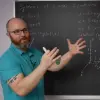

NARROW DISPLAY WARNING
You are most likely using a tablet or mobile device in portrait orientation. This website is best viewed using a typical computer screen with the browser window maximized.
Viewing this website in portrait orientation can cause problems with equations being longer than the screen width (you can scroll to the right), images being poorly sized, and the font size of maths text being much smaller than regular text. If your only option is a tablet or mobile device, your viewing experience will be better if you view this website in landscape orientation. You might need to refresh the page to fix any problems after rotating.
This page contains a list of Laplace Transforms for common functions. Rather than computing the Laplace transform every time, looking up the transform in the table is much easier. The table can also be used to perform the inverse Laplace Transform. If you need the Laplace Transform for a function not included in the table, you can use WolframAlpha LaplaceTransform[ f(t), t, s] to compute it. Keep in mind that even a simple function can have a complicated Laplace Transform.
The above link leads to WolframAlpha with the following input.
LaplaceTransform[ sqrt(t), t, s]
Part of the output is
\begin{equation} \frac{\sqrt{\pi}}{2 s^{3/2}} \end{equation}The above link leads to WolframAlpha with the following input.
LaplaceTransform[ HeavisideTheta[t-4]*e^(3t), t, s]
Part of the output is
\begin{equation} \frac{e^{12 - 4 s}}{s - 3} \end{equation}The above link leads to WolframAlpha with the following input.
LaplaceTransform[ DiracDelta[t-2]*e^(-3t), t, s]
Part of the output is
\begin{equation} e^{-2(s+3)} \end{equation}The above link leads to WolframAlpha with the following input.
InverseLaplaceTransform[ e^(-3s)*2/(s^2+4), s, t]
Part of the output is
\begin{equation} \theta(t - 3) \sin\big(2 (t - 3)\big) \end{equation}Where $\theta(t)$ is the Heaviside function.
The above link leads to WolframAlpha with the following input.
InverseLaplaceTransform[ 3*e^(-5s), s, t]
Part of the output is
\begin{equation} 3 \delta(t - 5) \end{equation}Where $\delta(t)$ is the Dirac delta function.
| $f(t) = \mathcal{L}^{-1}\{ F(s) \}$ | $\mathcal{L}\{ f(t) \} = F(s)$ |
|---|---|
| $cf(t)$ | $cF(s)$ |
| $1$ | $\dfrac{1}{s}$ |
| $e^{at}$ | $\dfrac{1}{s-a}$ |
| $t^{n} \text{ for } n=1,2,3,\ldots$ | $\dfrac{n!}{s^{n+1}}$ |
| $\sin(at)$ | $\dfrac{a}{s^{2}+a^{2}}$ |
| $\cos(at)$ | $\dfrac{s}{s^{2}+a^{2}}$ |
| $t\sin(at)$ | $\dfrac{2as}{(s^{2}+a^{2})^{2}}$ |
| $t\cos(at)$ | $\dfrac{s^{2}-a^{2}}{(s^{2}+a^{2})^{2}}$ |
| $e^{at}\sin(bt)$ | $\dfrac{b}{(s-a)^{2}+b^{2}}$ |
| $e^{at}\cos(bt)$ | $\dfrac{s-a}{(s-a)^{2}+b^{2}}$ |
| $t^{n}e^{at} \text{ for } n=1,2,3,\ldots$ | $\dfrac{n!}{(s-a)^{n+1}}$ |
| $H(t-c)$ | $\dfrac{e^{-cs}}{s}$ |
| $\delta(t-c)$ | $e^{-cs}$ |
| $H(t-c)f(t-c)$ | $e^{-cs}F(s)$ |
| $f'(t)$ | $sF(s)-f(0)$ |
| $f''(t)$ | $s^{2}F(s)-sf(0)-f'(0)$ |
| $f^{(n)}(t)$ | $s^{n}F(s)-s^{n-1}f(0)-s^{n-2}f'(0)- \cdots -sf^{(n-2)}(0)-f^{(n-1)}(0)$ |